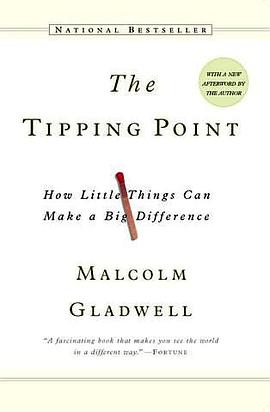

具体描述
"The best way to understand the dramatic transformation of unknown books into bestsellers, or the rise of teenage smoking, or the phenomena of word of mouth or any number of the other mysterious changes that mark everyday life," writes Malcolm Gladwell, "is to think of them as epidemics. Ideas and products and messages and behaviors spread just like viruses do." Although anyone familiar with the theory of memetics will recognize this concept, Gladwell's The Tipping Point has quite a few interesting twists on the subject.
For example, Paul Revere was able to galvanize the forces of resistance so effectively in part because he was what Gladwell calls a "Connector": he knew just about everybody, particularly the revolutionary leaders in each of the towns that he rode through. But Revere "wasn't just the man with the biggest Rolodex in colonial Boston," he was also a "Maven" who gathered extensive information about the British. He knew what was going on and he knew exactly whom to tell. The phenomenon continues to this day--think of how often you've received information in an e-mail message that had been forwarded at least half a dozen times before reaching you.
Gladwell develops these and other concepts (such as the "stickiness" of ideas or the effect of population size on information dispersal) through simple, clear explanations and entertainingly illustrative anecdotes, such as comparing the pedagogical methods of Sesame Street and Blue's Clues, or explaining why it would be even easier to play Six Degrees of Kevin Bacon with the actor Rod Steiger. Although some readers may find the transitional passages between chapters hold their hands a little too tightly, and Gladwell's closing invocation of the possibilities of social engineering sketchy, even chilling, The Tipping Point is one of the most effective books on science for a general audience in ages. It seems inevitable that "tipping point," like "future shock" or "chaos theory," will soon become one of those ideas that everybody knows--or at least knows by name. --Ron Hogan, Amazon.com
作者简介
Malcolm Gladwell is a former business and science writer at the Washington Post. He is currently a staff writer for The New Yorker.
目录信息
读后感
《引爆流行》中的“个别人物法则”、“附着力因素法则”、“环境威力法则”很好地解释了流行潮发生的原因。 我尝试着用这三个法则分析了一下“超女”的流行: 个别人物法则:通过组织“超女”们的fans,使“超女”成为联系员。 附着力因素法则(事物传递的信息):用PK、女...
评分原分几次发表在我的blog上,现在整理了一下供大家参考。不过这里没有了链接,如果不舒服的话,请移步这里:http://www.xinghan.net/index.php/post/7 ps:又从网站推广的角度对引爆流行的理论进行一些案例性分析,就不写在这里了,有兴趣的同学请看这里:http://www.xingha...
评分翻译的太不怎么样了!简直惨不忍睹! 钱清还是北大教翻译的,真实难以置信。是让学生翻的吧? 比如第一页第六句,People were going to the Ma and Pa stores, the little stores that still carried them, and buying them up. Ma and Pa ...
评分过去读过一次,觉得还好而已。有一些不错的点子,不过毕竟这么老的书了。。。。看完后推荐Dan and Chip heath的switch和Made to stick,有更深层次的讨论和更详细的例子。 ============================================== 传播的媒介(人): super connect...
评分原分几次发表在我的blog上,现在整理了一下供大家参考。不过这里没有了链接,如果不舒服的话,请移步这里:http://www.xinghan.net/index.php/post/7 ps:又从网站推广的角度对引爆流行的理论进行一些案例性分析,就不写在这里了,有兴趣的同学请看这里:http://www.xingha...
用户评价
对一个做营销的人来说挺有应用意义的。感觉书前半部分写得不错,后半部分就是把前半部分讲的东西颠过来倒过出重复讲。。。
评分生动,实用。希望记住里面的点,以后可以应用。配合另一本Nudge食用效果更佳。
评分完全名过其实的一本书。全书可以用一页讲完:流行靠关键节点、感染力以及具体环境。然而作者靠车轱辘话翻来覆去(注意了这人是来事的关键,上节咱们说了这人很关键,都听好了要来事就得跟上上章的这人学!),堆砌许多不相关的案例(有些和epidemics根本没关系),能拉长到一本书。这书本质上是市场营销书,以稀释过的社会学和心理学为卖点。就像培训师一样,案例越多越好,重复越多次越好,正说反说掰碎了说,抖个机灵卖个新鲜,而读者大可不必深入思考。这种文风适合公开演讲,适合去TED,不适合写书。在听这本书之前,我刚听了另一本畅销书Freakonomics。两本书都以通俗社会科学作为主题,都谈到纽约90年代犯罪率反常下降、父母对子女后天影响其实有限等话题,相比较本书的解释分析就要浅尝辄止得多。
评分十多年前的商务销售理论指南,其中一些原理还是有用的,但不得不说今日网络的飞速发展已经带来了巨大的不同和挑战。
评分: C912.6/G543
相关图书
本站所有内容均为互联网搜索引擎提供的公开搜索信息,本站不存储任何数据与内容,任何内容与数据均与本站无关,如有需要请联系相关搜索引擎包括但不限于百度,google,bing,sogou 等
© 2025 book.quotespace.org All Rights Reserved. 小美书屋 版权所有




















